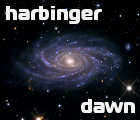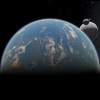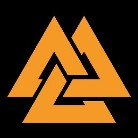|
Large scale structures with procedurally generated sufaces
|
|
| werdnaforever | Date: Wednesday, 27.06.2012, 02:09 | Message # 1 |
 World Builder
Group: Users
 Pirate
Pirate
Messages: 897
Status: Offline
| I think large scale structures- dyson spheres or ring worlds, would be an interesting addons for SE. However, I'm not just talking about meshes. I think it would be cool to take the same techniques for procedurally generating planets, stars, etc, and applying them to these large scale structures.
You could have a ringworld around a star- but one where the terrain is generated procedurally. The terrain could be along the surface of a mesh. The shape of the mesh would be simple, perhaps on a ringworld it would have simple walls reaching just above the atmosphere. The point is that the surface of the mesh would be the basis for a procedurally generated surface- in this case a pattern of metal,"scrith", or whatever fictional material your heart desires.
Or you could have a dyson shell, where you can see a pattern of metal panels and (on the inside) solar energy collectors.
I'm not sure how possible those is, especially with an addon. I'd suggest that they could be built into SE (as unbelievably rare) but this isn't something realistic and not everyone would like them.
My main point is that allowing addons this large to take advantage of procedural generation of terrains/surfaces would make things much more interesting. There was a cool addon for celestia- it was the ringworld from Larry Niven's novel, and although it had small models of people and ships from the book, it lacked surface detail since Celestia relies on meshes and textures, and you can't go into that much detail on a model so large if that's what your using to make it. Allowing things to be procedurally generated would make for endless interesting possibilities for future addons in SE.
If there was an SE SDK that allowed for this, that would probably help. Still I'm not sure how easy it would be to do any of this.
A more minor point- if ringworlds/dyson shells were built into the engine, they could be considered "easter eggs". There could be a checkbox in the options to enable such easter eggs, which would allow for them to be generated. They would be really rare- finding one would be a miracle. It would add some interesting exploration options- you could land a ship on one or something if you actually found one. There would be anywhere from 0 to 10 large scale structures in a galaxy.
|
| |
| |
| HarbingerDawn | Date: Wednesday, 27.06.2012, 02:32 | Message # 2 |
 Cosmic Curator
Group: Administrators
 United States
United States
Messages: 8717
Status: Offline
| Quote (werdnaforever) If there was an SE SDK that allowed for this, that would probably help.
I think that that would be the only way for things like this to happen. There are plenty of great projects and ideas out there (an infinite number of them, really) that would be awesome to see in SE but which kinda fall outside the scope of the main development. An SDK would allow for people's visions to come to life without sacrificing the focus of the dev team on the main goal. There are so many things that I would like to see in SE, but the last thing I want is for development to get off track by trying to implement every cool idea there is. An SDK would allow the community to do work towards making those things a reality.
All forum users, please read this!
My SE mods and addons
Phenom II X6 1090T 3.2 GHz, 16 GB DDR3 RAM, GTX 970 3584 MB VRAM
|
| |
| |
| werdnaforever | Date: Wednesday, 27.06.2012, 03:03 | Message # 3 |
 World Builder
Group: Users
 Pirate
Pirate
Messages: 897
Status: Offline
| Exactly.
I think the hardest part would be when it comes to where terrain and textures are generated. As far as I can tell, there would be two main options. (I'm using the ringworld as an example)
The first would be generating it on one side of a surface. For example, the terrain of a ringworld would be based on an invisible ring (like a strip of paper in a circle). Terrain would be generated along the inside of the ring.
Now, the edge of the terrain would be "open", so you would see under it, as if you were looking under a floating, deformed blanket. This is where the second option comes in. A mesh would surround the ring of terrain on the outside. It would be a ring with two walls to "hold" the terrain inside it. The texture for the mesh would be procedurally generated- metal panels or whatever building material you want.
You could even have basic mesh shapes be procedurally generated- a ring shaped mesh will not have enough detail (it is made of triangles, and you can only have so many) so zooming in to the surface will show the individual sides, rather than a curved edge. If you could procedurally generate a mesh then you could have a perfect cylinder or ring shape that won't loose detail as you zoom in.
I hope that doesn't sound confusing.
|
| |
| |
| HarbingerDawn | Date: Wednesday, 27.06.2012, 03:13 | Message # 4 |
 Cosmic Curator
Group: Administrators
 United States
United States
Messages: 8717
Status: Offline
| I completely get what you're saying. It sounds possible, though it would take a lot of work. Probably the most difficult thing would be finding a way to model an atmosphere for the ring, it would be really different from how atmospheres are normally applied in programs like these.
All forum users, please read this!
My SE mods and addons
Phenom II X6 1090T 3.2 GHz, 16 GB DDR3 RAM, GTX 970 3584 MB VRAM
|
| |
| |
| apenpaap | Date: Wednesday, 27.06.2012, 12:17 | Message # 5 |
 World Builder
Group: Users
 Antarctica
Antarctica
Messages: 1063
Status: Offline
| I really love the idea of Dyson spheres and ringworlds very occassionally happening in SE. I'm guessing we'll have to wait for life to be more distinctly generated, like planets with only bacterial life, planets with plant life, planets with lower animals, etc. before anything like this can even begin to be considered, though.
I occasionally stream at http://www.twitch.tv/magistermystax. Sometimes SE, sometimes other games.
|
| |
| |
| SpaceEngineer | Date: Wednesday, 27.06.2012, 13:15 | Message # 6 |
 Author of Space Engine
Group: Administrators
 Russian Federation
Russian Federation
Messages: 4800
Status: Offline
| I have plans for implementing cylindrical-shaped landscape - it will be useful not only for ringworlds, but for rotating space stations for example. Adapting a landscape system to that shape is not really hard. But the hard part is the atmosphere, as HarbingerDawn noted. However, Eric Bruneton already made something like I said, so he probably has the code for a cylindrically-shaped atmosphere (however, in this demo he may use a simple uniform-density atmosphere).
*

|
| |
| |
| werdnaforever | Date: Friday, 29.06.2012, 23:35 | Message # 7 |
 World Builder
Group: Users
 Pirate
Pirate
Messages: 897
Status: Offline
| Quote (SpaceEngineer) However, Eric Bruneton already made something like I said, so he probably has the code for a cylindrically-shaped atmosphere (however, in this demo he may use a simple uniform-density atmosphere).
I've seen this before. Sir Clarke would be proud.
It does look like he used a uniform density atmosphere- in his "making of" PDF he describes atmospheric scattering, but I don't think he mentioned variations from the edge to the middle (unless it's buried in one of those equations or I accidentally overlooked it). I'm not sure any code he has would help unless he's made some secret updates... 
|
| |
| |
| Hasforjs97 | Date: Monday, 09.07.2012, 17:29 | Message # 8 |
 Space Pilot
Group: Translators
 Spain
Spain
Messages: 107
Status: Offline
| Quote (werdnaforever) ring worlds
It would be nice to have... prodecudally-generated HALOs 
My desktop:
Pentium G3260 @ 3.30GHz
8.0 GB DDR3
AMD Radeon HD 5570 1GB
|
| |
| |
| apenpaap | Date: Monday, 09.07.2012, 18:07 | Message # 9 |
 World Builder
Group: Users
 Antarctica
Antarctica
Messages: 1063
Status: Offline
| Thinking about how civilisation could be implemented in SE, I suggest subdividing planets with life based on how advanced they are:
Terra/Oceania with...
...Life: Used for simple, prokaryotic or noncellular lifeforms. I'm thinking this type of life could also arise on Deserts and Ice Worlds and Titans. The planet looks just like a dead planet.
...Eukaryotic Life: Used for planets with monocellullar eukaryotic lifeforms, so when the prokaryotic endosymbioses form more complicated cells with many different organells. There could be splatches of green/whatever colour the planet's chlorophyll is in the planet's oceans to simulate photosynthetic organisms.
...Multicellular life: Planets with multicellular, but marine eukaryotic lifeforms. They would look the same as the planets with just single-celled eukaryotic life.
...Terrestrial life: Planets with multicellullar organisms living on land. Obviously this step is skipped on Oceanias. These planets would look like the living planets do now, with forests and plants on the continents.
...Intelligent life: Planets with primitive intelligent lifeforms without civilisation or more than the most basic technology. They would still look the same as the planets with Terrestrial life.
...Civilised life: Of course, the word 'civilisation' is wide open to interpretation, but in this case I would define it as planets where intelligent creatures live in cities, or their equivalent of it, and have some technology, though not on industrial levels. These would have somewhat less forests, small cities, and possibly agriculture. Not sure how an Oceania would look like with this or any of the later ones, though.
...Industrial life: Planets where their equivalent of the industrial revolution has happened. Few forests, large cities that produce night lights on the night sky, and possibly a stronger greenhouse effect. Planets with this classification can also have small colonies on other worlds in their solar system, especially their moons/ other moons of their parent planet and other planets with an orbit close to their homeworld.
...Class I Kardeshev civilisation: Planets with even larger cities than on industrial ones, but mainly more spread. Probably inhabitation near hydrothermal vents in the ocean and such as well. Despite this, the planet has more forests than industrial worlds and a natural greenhouse effect. Most solid worlds in the solar system have small colonies on them, and nearby ones possibly have extensive colonies on them or show signs of partial terraforming.
...Class II Kardeshev civilisation: Not quite sure how they would be represented. A Dyson Sphere or a ringworld are possibilities. Another is to have a system with the planets intact, but large solarpanel-like things/corona harvesters or other ideas at their sun's poles, while all terraformable worlds in the system are terraformed, the original planet is covered by city for a large amount, and all non-terraformable worlds have large colonies on them. Possibly colonies at other nearby stars as well, but I don't think this is possible with procedural generation...
...Class III Kardeshev civilisation: This one isn't asigned on a planetary or solar system basis, but an entire galaxy gets this, in which case every solar system in the galaxy gets a Class II like look. There could possibly be things like industrial nebulae.
Obviously, these should become rarer and rarer with each ongoing step. A problem is, of course, that it's rather Earth-centric, even though I've tried to keep it as general as possible.
I occasionally stream at http://www.twitch.tv/magistermystax. Sometimes SE, sometimes other games.
|
| |
| |
| Methis | Date: Monday, 30.07.2012, 00:56 | Message # 10 |
 Space Tourist
Group: Users
 Netherlands
Netherlands
Messages: 35
Status: Offline
| I don't mean to resurrect, but about the atmosphere... I'm assuming that the spherical atmosphere model is essentially a sphere with particular (and well-adjusted) fog falloff parameters, correct? I imagine that for a Dyson sphere, these parameters would be more or less reversed. (Of course it's more detailed than this, but in essence...).
As for a ringworld.. I think this type of cylindrical atmosphere would have certain advantages as there's several features that it won't require since they don't apply, namely things such as the colouring of the atmosphere that is best observed during sunset/rise (atmospheric extinguishing, is it called?).
Unless you had some really unique cases in mind, a density-dependant type of fog might even suffice, as the main light source is always going to be in the same position to any point on the surface... Or am I being to simple about this? :þ
|
| |
| |
| werdnaforever | Date: Saturday, 21.03.2015, 04:58 | Message # 11 |
 World Builder
Group: Users
 Pirate
Pirate
Messages: 897
Status: Offline
| Regarding the atmosphere model for ring shaped colonies, it wouldn't actually be very difficult. You start with a central axis; the entire atmosphere is contained within a cylinder that snugly fits inside the ring. Atmospheric properties, like the density of the air, would be defined at different radii from the center.
You'd have variables for the outer edge (ground level), the inner edge (where the atmosphere ends and space begins), and a function or two or whatever to define how all those values change in-between.
Something along those lines, anyway. But it should be do-able.
Edited by werdnaforever - Saturday, 21.03.2015, 04:58 |
| |
| |
 ENG
ENG




 Pirate
Pirate 


 United States
United States  Antarctica
Antarctica  Russian Federation
Russian Federation 


 Spain
Spain 
 Netherlands
Netherlands